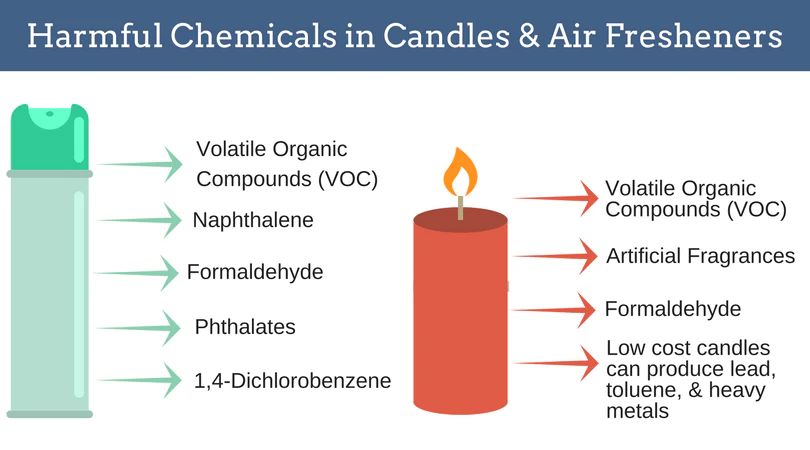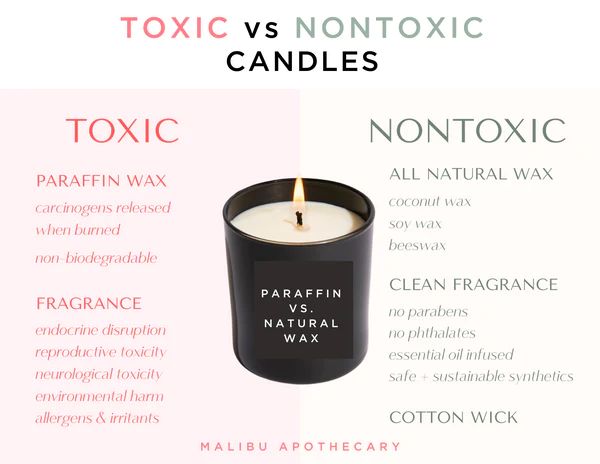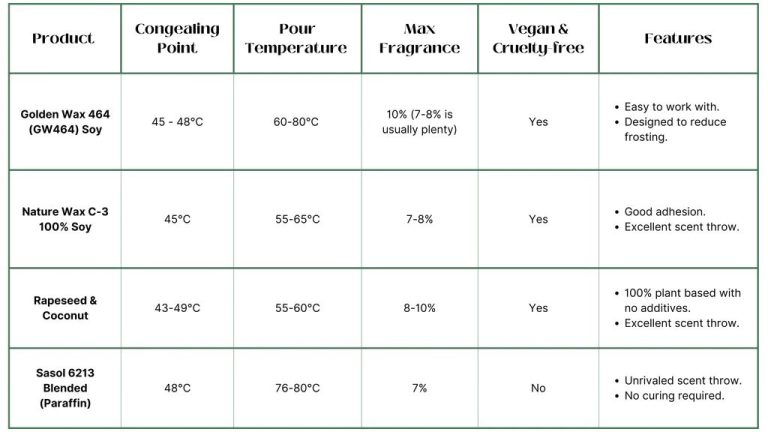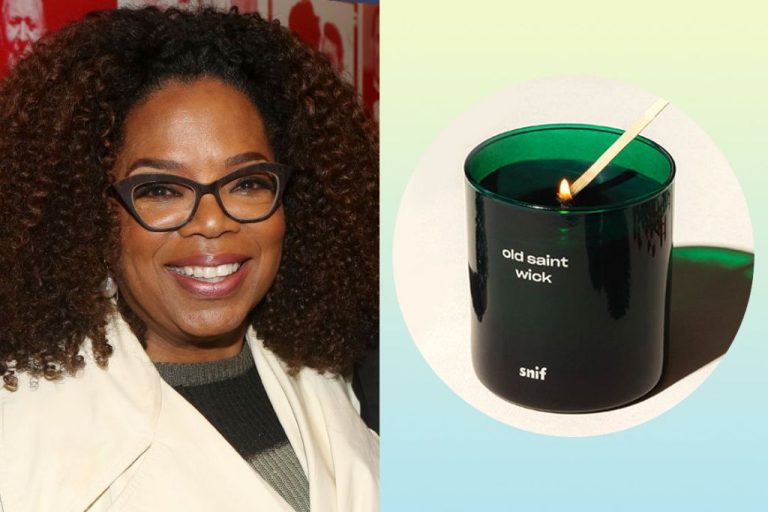Are Fumes From Candles Harmful?
Candles are an extremely popular household item, used in over half of American homes. According to the National Candle Association, more than 1 billion pounds of wax are used annually in candle production in the United States alone (https://candles.org/facts-figures-2/). Candles serve decorative, aromatic, and lighting purposes. With the wide variety of scents, colors, and shapes available, there is a candle for every preference. Some enjoy candles for relaxation or to set a mood, while others use them for religious practices or aromatherapy. The versatility and customizability of candles contribute to their widespread appeal and ubiquity in modern households.

Common Ingredients
Candles are made from a variety of ingredients, but some of the most common include:
Paraffin wax – This petroleum-based wax is the most widely used in candles because it is inexpensive and easy to work with. However, paraffin wax produces more soot than other waxes when burned, which may release toxins. (Source: Safe Scents Shop)
Soy wax – Made from hydrogenated soybean oil, soy wax is a renewable and biodegradable alternative to paraffin. It burns cleaner than paraffin with less soot. Some people prefer soy wax because it is made from a sustainable resource. (Source: Safe Scents Shop)
Beeswax – Beeswax is a natural wax produced by honey bees. It has a subtle honey aroma when burned. Beeswax candles burn slowly and emit minimal soot. However, beeswax candles can be more expensive than paraffin or soy.
Essential oils – These natural plant oils provide fragrance in candles. Common essential oils used include lavender, eucalyptus, citrus oils, peppermint, and tea tree. While essential oils are derived from plants, some may cause reactions in sensitive individuals when burned.
Potentially Harmful Chemicals
Burning candles releases chemicals into the air that may have harmful health effects. The main concerning chemicals are:
- Soot – The black carbon residue left behind from incomplete candle combustion. Inhaling soot particulates can irritate lungs. (1)
- Volatile Organic Compounds (VOCs) – Candles emit VOCs like benzene, toluene, and xylene which may cause headaches, dizziness, and irritate airways. VOCs have also been linked to cancer risks. (1)
- Polycyclic Aromatic Hydrocarbons (PAHs) – These compounds are released from burning candle wicks and may disrupt hormones and increase cancer risk with long-term exposure. (2)
While more research is still needed, these chemicals present potential health hazards that should be considered with regular candle usage, especially indoors. Proper ventilation can help reduce exposure risks.
(1) https://www.today.com/health/burning-candles-bad-for-you-rcna80223
(2) https://www.healthline.com/health/are-candles-bad-for-you
Exposure Risks and Effects

Burning candles can release potentially harmful chemicals into the air through inhalation. According to studies, scented candles contain volatile organic compounds (Al Khathlan et al., 2023), which can negatively impact indoor air quality and irritate the lungs when inhaled.
Specifically, ingredients like synthetic fragrances and paraffin wax produce fine particulate matter when burned. The small size of these particles allows them to penetrate deep into the lungs. Short-term exposure may result in coughing, wheezing, and shortness of breath. Frequent exposure could potentially lead to more chronic respiratory issues over time.
Burning multiple candles or keeping them lit for prolonged periods can compound risks by increasing the concentration of pollutants circulating indoor air. Proper ventilation is important, but may not completely mitigate exposure to candle emissions (Farooq, 2023). Those with asthma, allergies, or other sensitivities may experience heightened reactions.
Factors Influencing Risk

Several factors can influence the risk associated with inhaling candle fumes, including ventilation, burn time, and flame size.
Proper ventilation is key to minimizing exposure to candle emissions. Burning candles in a small, enclosed space with no airflow allows chemicals to accumulate to much higher concentrations. Large, well-ventilated rooms will help dissipate and dilute fumes. Opening windows, using ceiling fans, and placing candles away from high traffic areas promotes air circulation (Source).
Longer burn times also increase the amount of chemicals released into the air. Limiting burn sessions to 1-2 hours can reduce accumulation of particulate matter. Extinguishing candles when leaving a room is recommended (Source).
Larger flame sizes generate more soot and fumes. Using candles with cotton vs paper wicks and trimming wicks to 1⁄4 inch helps control flame height. Properly sized flames that aren’t smoky also indicates complete wax melting and an ideal burn (Source).
Special Considerations
Certain groups may be more susceptible to potential health effects from candle fumes. This includes people with allergies, asthma, and other respiratory conditions. The chemicals and particulates released from candles can exacerbate allergy and asthma symptoms, triggering coughing, wheezing, and difficulty breathing ([1]). Children and infants are also at higher risk since their lungs are still developing and they breathe more rapidly than adults.
Pets can be sensitive to candle fumes as well. Cats and birds appear to be particularly susceptible according to veterinarians, likely due to their smaller lung capacity compared to humans. Signs your pet may be affected include lethargy, coughing, sneezing, and watery eyes after candle use. Keeping pets away from rooms where candles are burned can help reduce risks.
In general, those with pre-existing respiratory issues, the very young, and pets should take extra precautions around candles. Ventilating rooms, keeping candles away from bedrooms, and blowing them out when not actively being monitored can all help mitigate potential hazards.
Minimizing Exposure

There are some steps you can take to minimize your exposure to potentially harmful chemicals and particles from candle burning:
- Use safer candles made from beeswax, soy, or other natural waxes instead of paraffin. Beeswax and soy candles have been found to produce less soot and smoke (https://cehn.org/our-work/eco-healthy-child-care/ehcc-faqs/candles/).
- Avoid burning candles for more than 1-2 hours at a time. Longer burn times allow more soot and particles to accumulate.
- Make sure there is adequate ventilation when burning candles by opening windows or doors to allow air flow. This will prevent buildup of particles and help dilute any volatile organic compounds.
- Trim wicks to 1⁄4 inch before lighting to prevent smoking and sooting.
- Keep candles away from drafts, vents, and fans to minimize uneven burning and smoking.
Taking simple precautions like using less toxic candles, avoiding excessive burn times, and ensuring proper ventilation can help minimize risks from candle fumes.
Myths vs Facts
There are some common myths and misconceptions around whether candle fumes are harmful. One of the biggest myths is that burning candles produces toxic fumes. However, research shows this is generally not true for most well-made candles. Studies by the National Candle Association found that properly wicked candles do not release toxic chemicals or harm indoor air quality when burned.
Another myth is that soy candles are inherently safer or less toxic than paraffin wax candles. While soy wax is marketed as a more natural alternative, there is no evidence it produces fewer fumes or is safer overall. Both soy and paraffin candles produce some fumes, but these are not believed to be hazardous in normal use if the candle is high quality and the wick is trimmed properly.
When to Be Concerned
Certain signs may indicate excessive exposure to chemicals from candle burning. These include persistent or worsening respiratory symptoms like coughing, wheezing, chest tightness, and shortness of breath. Headaches, dizziness, nausea, and irritation of the eyes, nose, throat, and skin are also potential symptoms of too much exposure to candle fumes (https://www.onehourheatandair.com/articles/expert-tips/air-quality/are-candles-bad/) (https://www.nytimes.com/2021/11/09/well/scented-candles-health.html).
If you experience any of these symptoms consistently while burning candles, it’s a good idea to stop using them and see if the symptoms improve. You may want to consult a doctor if symptoms are severe or don’t go away after stopping candle use. Asthma sufferers should take extra precautions, as fragrances and particulates from candles can trigger attacks. Anyone with respiratory issues should avoid extensive use of scented candles (https://www.onehourheatandair.com/articles/expert-tips/air-quality/are-candles-bad/).
In general, pay attention to how you feel when burning candles. Your body may give cues if ventilation is insufficient or you are sensitive to particular candle ingredients. Most occasional candle usage is safe, but be mindful of health symptoms that may signal it’s time to stop or cut back.
Summary
While the risks from candle fumes are generally low, exposure to the chemicals they emit may cause irritation or other health effects for some. Those most at risk include young children, the elderly, pregnant women, and people with respiratory conditions. However, taking simple precautions can greatly reduce or eliminate risks. Safer alternatives like beeswax or soy candles, ensuring proper ventilation, trimming wicks, and limiting burn times can allow you to safely enjoy candles. Ultimately, listen to your body and discontinue use if you experience symptoms. With awareness and care, candles can be used by most people without significant concern.






